|
| |
- This page contains pictures and information about Jumping Spiders Biology
in general.
-
 - Male jumping spider protecting his nest and a female.
-
- Jumping Spider is a very large family contains the most colourful species of spiders.
They are small to medium size. They
are easily recognized by their eyes pattern. Their front pair of eyes are very
large, with another three pair of smaller eyes on thorax, in three row of
4-2-2. They have very good eyesight and actively hunting during the day. The arrangements
of their four pairs of eyes made their vision covers virtually entire 360 degree.
-
- Each species in this family have different colourful patterns on
their body. When you look at them, they will either hide away on
the other side of the leaf or will turn their head and look back at
you.
-
-

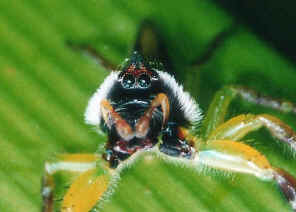

-
- Jumping spiders are called Pussy Cat in Chinese. The above pictures show
jumping spiders with cat's face, this may explain why they are called.
-
-
-
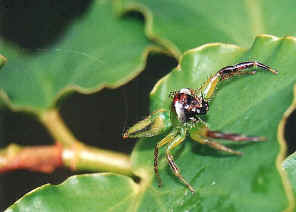 

-
- When jumping spiders move or jump, they always leave a
safety line of silk, or the drag-line, behind. Look carefully at the about first
pictures
you can see the drag-line attached from the spider abdomen tip to a leaf. If the jump
missed the spiders can always climb back to its
original position.
-
- More
information about spiders and their silk can be found in this page.
-
Hunter on Leaf and stem
-
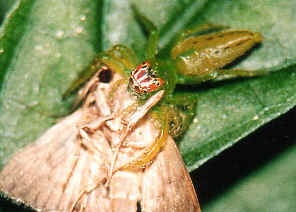 
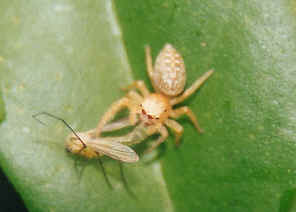
-
- Jumping Spiders hunt on plants during the day. They have complex eyes system
and considered to be the best vision among all the animals of their size. The
eyes of jumping spider, especially the largest pair of eyes, are constructed
very differently from vertebrate and insect eyes. Each eye has a long eye tube
which is attached with a set of muscles, it is capable of precise rotate and
move.
-
-
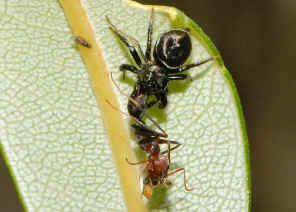


-
- However, jumping spider's eyes can not adjust the focus. The retinas have
a four-layer and tiered arrangement. There is another lens just in front of the
retina. This makes the spider's eyes a telephoto lens system. The spider can see
sharp image ranging from one body length to infinity. It is also believed the
jumping spider can see colours.
-
- They use their excellent vision to
track the prey and estimate distance. Then suddenly jump on their prey. They
use their third and fourth pair of legs for jumping. They seize prey by front
pair of legs.
Hunter on Tree Trunk



-
- The jumping spiders also hunt on bark, it is well camouflage.
Hanging from its safety-line, it jumps down, swings and lands on the
insect
when the insect just lands on the tree trunk.
-


 -
- Jumping spiders do not build webs. They make silken retreats between leaves, barks or stones.
Their retreats usually have opening at both ends. They hide in their
retreats at night and during winter.
-
 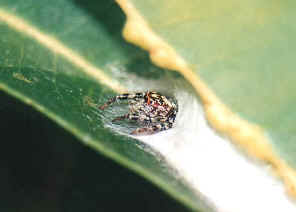

-
- Some jumping spiders build retreat and eggs sac on single or double green
leaves.
-

 -
- Some jumping spiders build retreat on tree trunk
-
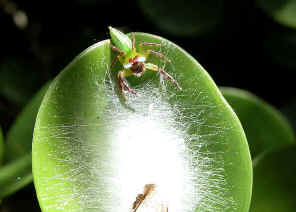
 -
- The females lay eggs in their
retreats in spring and summer. Their number of eggs is relatively fewer than
most other spiders. Female spiders will guard their eggs. Usually Jumping
Spiders will not hunt too far away from their retreats. Male and female may
live together in mating season. This is not common in other spider
families.
-
As Prey
-

 
-
-
Jumping Spiders are the predator of small spiders and insects. However, we
found that Jumping spiders are the prey of the Mud-Dauber
Wasps. They are also prey if they fall onto the web of Web
Building Spiders.
-
-
- Reference:
- 1. A Guide to Australian Spiders - Densey Clyne, Melbourne, Nelson
1969, p51.
- 2. Family
SALTICIDAE Blackwall, 1841 - Australian Faunal Directory, Australian Biological Resources Study.
- - Australian Biological Resources Study.
- 3. PREDATORY BEHAVIOR OF JUMPING SPIDERS
- R.R. Jackson and S.D. Pollard, Annual Review of Entomology, Vol. 41: 287-308 (January 1996).
- 4. Australia - List of Species of Salticidae - by Jerzy Proszynski, 1999.
-
- Back to top
[ Up ] [ Jumping Spiders Biology ] [ Genus Opisthoncus ] [ Genus Sandalodes ] [ Genus Mopsus ] [ Under-bark Jumping Spider ] [ Genus Myrmarachne ] [ Small Brown Jumper ] [ Jumping spiders ] [ Unidentified Jumping Spiders ] | |
|





























